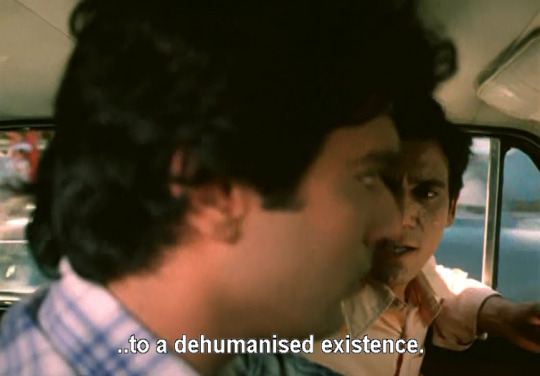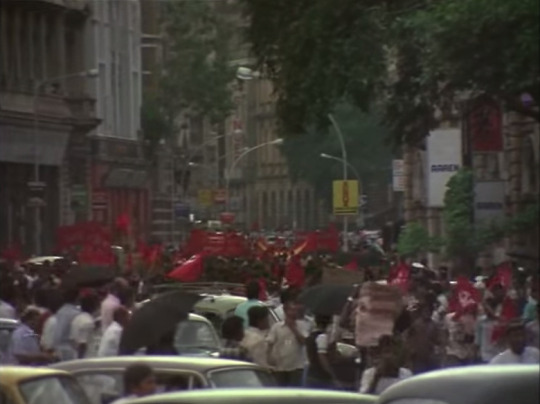#arvind desai ki ajeeb dastaan
Explore tagged Tumblr posts
Photo



Arvind Desai Ki Ajeeb Dastaan (1978)
5 notes
·
View notes
Text

Arvind Desai Ki Ajeeb Dastaan, 1979 Film Poster
#art#digital art#artist on tumblr#graphic design#graphic art#lettering#typography#hindi#film poster#writing#graphic#devanagri#drawing#desi#hindi cinema#old cinema#type
1 note
·
View note
Photo








Bombay, 1978 by taxi and by car in Gaman (Muzaffar Ali, 1978) and Arvind Desai Ki Ajeeb Dastaan (Saeed Akhtar Mirza, 1978).
#gaman#muzaffar ali#arvind desai ki ajeeb dastaan#saeed akhtar mirza#hindi cinema#indian cinema#bombay#gif warning#did it take my 100 years to realize they were made in the same year? yes
134 notes
·
View notes
Text
I see my films as essays, which you can accept or reject: Saeed Mirza
I see my films as essays, which you can accept or reject: Saeed Mirza
[ad_1]
There was a time when his films showed us the other side of the popular view. Films like Arvind Desai Ki Ajeeb Dastaan, Albert Pinto Ko Gussa Kyun Ata Hai, Mohan Joshi Hazir Ho and Salim Langde Pe Mat Ro weren’t just lengthy titles, they reflected the unwieldy side of our democracy as well. Now in his latest book, a collection of essays, tales and folktales, Saeed Akhtar Mirza has decoded…
View On WordPress
#Anuj Kumar#Arvind Desai Ki Ajeeb Dastaan#Kaifi Azmi#Memory In The Age of Amnesia#Naseem#Saeed Akhtar Mirza#Salim Langde Pe Mat Ro
0 notes
Link
Happy Birthday, Saeed Akhtar Mirza.
"While picking up the stories he wanted to tell, Mirza was keen to capture the people lost in between the isles of power and the class differences.
His free-flowing camera penetrated ghettos, gullies, slums, tin-roofed houses, and into the mindscapes of grumpy individuals, and returned with the immortal spirits of survival."
Click To Read More-
#akhtar mirza#albert pinto ko gussa kyoon aata hai (1980)#ammi: letter to a democratic mother#arvind desai ki ajeeb dastaan#ek tho chance#saeed akhtar mirza#bollywoodirect
0 notes
Text
Arvind Desai Ki Ajeeb Dastaan (1978)
Arvind Desai Ki Ajeeb Dastaan (1978)
Arvind Desai Ki Ajeeb Dastaan (1978) is a 2021 India N/A language Sci-Fi film directed by Saeed Akhtar Mirza. Arvind Desai Ki Ajeeb Dastaan (1978) film stars Dilip Dhawan, Anjali Paigankar, Shreeram Lagoo, Sudha Shivpuri in supporting roles. Arvind Desai Ki Ajeeb Dastaan (1978) film premiered on 05 May 1978. Free download and watch Arvind Desai Ki Ajeeb Dastaan (1978) all episode. Arvind Desai Ki…
View On WordPress
1 note
·
View note
Photo

Arvind Desai Ki Ajeeb Dastaan (1978) Dilip Dhawan and Rohini Hattangadi were such babes back in the day.
#Arvind Desai Ki Ajeeb Dastaan#Saeed Akhtar Mirza#Dilip Dhawan#Rohini Hattangadi#1978#So in love with this film
5 notes
·
View notes
Photo



Arvind Desai Ki Ajeeb Dastaan (1978)
15 notes
·
View notes
Link
Cinema was primarily a medium of telling stories for Saeed Akhtar Mirza, who is a storyteller at heart and his techniques, narrative, and characterization are in concordance with the rich storytelling tradition of India.
#akhtar mirza#albert pinto ko gussa kyoon aata hai (1980)#ammi: letter to a democratic mother#arvind desai ki ajeeb dastaan#ek tho chance#saeed akhtar mirza
0 notes
Note
ruia i have a 5 day weekend!! what movies should i watch?? the weather is changing around me and i've been feeling very moody and introspective....
omg this is a mood i can get behind! hopefully you havent seen some of these:
antareen (1994)
asha jaoar majhe (2015)
a death in the gunj (2016)
siddheshwari (1989)
crossing bridges (2013)
sanjhbatir rupkathara (2002)
daera (1953)
aparoopa (1982)
ek din achanak (1989)
arvind desai ki ajeeb dastaan (1978)
shevri (2006)
ethrayum yathra bhagam (2003)
asukh (1999)
bhalo theko (2003)
gaman (1978)
snapshots from a family album (2003)
nirnay (2012)
drishti (1990)
rajnigandha (1974)
lekin... (1991)
hope you enjoy your weekend!!!!
75 notes
·
View notes
Photo


Arvind Desai Ki Ajeeb Dastaan (1978)
73 notes
·
View notes
Photo





Arvind Desai Ki Ajeeb Dastaan (1978)
166 notes
·
View notes
Photo




tallying how many times kamal swaroop made a weird cameo / was mentioned in different films from this period
this one’s from saeed akhtar mirza’s arvind desai ki ajeeb dastaan (1978).
#i think he was an AD for saeed akhtar mirza?? or else just worked with him a lot#arvind desai ki ajeeb dastaan#im also 'that guy doing history'
39 notes
·
View notes
Photo






In 1962, when he wrote ‘Irani Restaurant Bombay’, Kolatkar wouldn’t have read Walter Benjamin’s essays, which were not then available to the Anglophone world, nor would he have heard of the arcade-haunting Parisian flaneur. But as a Bombay loafer himself, someone who daily trudged the city’s footpaths, particularly the area of Kala Ghoda, he would have recognized the figure.
‘Salo loafer!’ says a character in Cyrus Mistry’s play Doongaji's House. Over the centuries, ‘loafer’ has become almost an Indian word of abuse, suggesting a good-for-nothing who drifts through the city in self-absorbed fashion when, in fact, he is streetwise and his keen eye doesn’t miss a thing. Kolatkar himself seldom walked past a pavement bookstall without picking up a treasure. This is true of the loafer even when he appears most relaxed, having tea, say, in an Irani restaurant, a portrait of ‘the cockeyed shah of Iran’ displayed above the till and the whole place buzzing with flies. On these occasions, he is like a papyrologist in a library poring over a classical document, though the objects he could be studying are the tables, chairs, mirrors, and bazaar prints in whose midst he sits.
[ Arvind Krishna Mehrotra -- “Death of a Poet” ]
Screencaps from Percy (1989) and Arvind Desai Ki Ajeeb Dastaan (1978). These two scenes, in particular the former, came to mind immediately when I was reading this essay by Mehrotra on legendary Marathi/English poet Arun Kolatkar. Who else knew about Bombay more than Kolatkar after all? On that same note, I can’t think of anyone who has conceptualized this “loafer” and their city better than filmmakers like Saeed Akhtar Mirza and Pervez Mehranji (those these two films may not be perfect representations). Mehrotra even brings up Cyrus Mistry who actually wrote Percy!
#percy#arvind desai ki ajeeb dastaan#Pervez Mehrwanji#saeed akhtar mirza#arun kolatkar#arvind krishna mehrotra
191 notes
·
View notes
Photo



Arvind Desai Ki Ajeeb Dastaan (1979
48 notes
·
View notes
Photo










I honestly believe Saeed Akhtar Mirza is a master at representing the urbanscape through the vision and assessments of his lead characters, especially when it comes to those characters who hold historically marginalized identities. Thee of his early and most well known films Arvind Desai ki Ajeeb Dastaan (1978), Albert Pinto Ko Gussa Kyon Aata Hai? (1980), and Salim Langde Pe Mat Ro (1989) all take place in Mumbai (or Bombay as all these films were before the 1995 Shiv Sena led name change) and have their respective titular characters occupying various positions in society.
Arvind Desai is a straggling & disaffected upper-class, upper-caste Hindu, young businessman from a well-to-do family who spends a lot of time loitering the city in a nice car (Mirza’s trademark passing car shots of Bombay are quite amazing and becomes a repeated motif in many of his films) as he visits various people who occupy different places in the city due to their identities. For example, Alice, his Christian secretary, whose family he visits often, lives in a middle-class household and neighborhood which contrasts vastly with his own posh neighborhood and background. They often go on dates in nice restaurants in the very developed part of the city (Alice herself is a “loiterer”). He also visits his married sister who lives in a very polished yet lonely flat. He’s friends with a Marxist professor who is renting a modest room near the university he works at and the train is also very close to it. We are also shown the night route to even poorer neighborhoods where he visits a sex worker. Akhtar shows us the city’s street performers, the laborers, the working class, the middle class, the neighborhood divisions between different religious groups, the elite world of Bombay, etc. all through the window shield of Arvind’s car which serves as a reminder that his gaze and our own are outsiders.
On the other hand Albert Pinto Ko Gussa Kyon Aata Hai? (1980) & and Salim Langde Pe Mat Ro (1989) have us deep within the personal cities that the respective characters live in. Albert Pinto I would say is a lower-middle class Christian mechanic who, if Arvind was comfortably indifferent, is imbued with a rage that is the culmination of belonging to the oppressed working-class and having an identity that is devalued in an increasingly tepid environment. Albert also internalizes the classism prevalent in a capitalist society which leads him to alienate himself from his fellow workers down to his own neighbors and friends. His girlfriend Stella also works at an office and he visits often her somewhat better-off family and frequently gives her rides where we really see the urbanscape as being a deeply personal part of the lives of the characters, rather than something to gaze at. Akhtar also provides us with the sociopolitical happenings of the city through posters on walls to strikes being shown as encompassing the city until Albert himself can’t ignore or pretend to not understand their legitimacy.
In Salim Langde Pe Mat Ro, we extend from class tensions to the include fears and troubles of marginalized groups. Salim is another young man who is Muslim and belongs to a lower-class family. Here the city and the shots Akhtar takes, show the segregation and increasing marginalization of Muslims in Bombay as communal conflict is promoted by the rise of right-wing Hindu nationalist groups in such a diverse city. Salim is a “small-time goonda” who spends his days with family, hangs out wih his similar friends, and takes up various jobs. Akhtar showcases the Muslim neighborhoods lively and bustling with the day-to-day grind of the people in it with Salim being the guiding figure who weaves in and out of the crowds and neighborhoods. Akhtar completely fleshes out the various individuals Salim is acquainted with and in turn turns this part of the city into something that doesn’t fall into the 2-dimensional, stereotypical, and villainizing portrayals of Muslims in Bombay in popular media at the time (and even now), in fact I think I read this was his response to Bollywood’s portrayal of the Muslim villain vs. the righteous Hindu man. We see how oppressive the city has become for the lower-class Muslims in these neighborhood as every street has police offers on guard and poverty is inescapable, which is contrasted with the “other” Mumbai that is polished, clean, gentrified, and which accepts only certain identities.
(Tl;dr - Saeed Akhtar Mirza has provided truly some of the most defining work on exploring the identities of people in India who have been historically marginalized members of society through narratives that do not cheapen or simplify their experiences and the attention he pays to the city as a silent narrator of those experiences are amazing)
#saeed akhtar mirza#arvind desai ki ajeeb dastaan#albert pinto ko gussa kyon aata hai?#salim langde pe mat ro#don't cry for salim the lame
96 notes
·
View notes